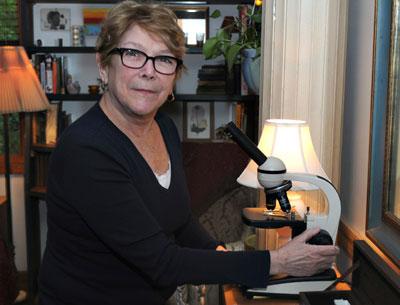She’s Got Binders of Ticks and a Mission

Since resigning from the East Hampton School Board in early July, Patricia Hope has not exactly had trouble filling her days.
In recent weeks, the former science teacher, who chaired the East Hampton High School science department for eight years before retiring in 2007, has turned her attention toward the cataloging of local ticks and mites.
“I’ve always been interested in the ecosystem that I live in,” said Ms. Hope, who has taken up a study of her surroundings, focusing on the immediate habitat that borders her property in Northwest Woods. “I’m an amateur naturalist.”
Prior to resigning from the school board, Ms. Hope had served for the past year as its outspoken president. J.P. Foster now holds the position. Looking at the year ahead, Ms. Hope said the current configuration of the board was such that she felt she would be doing “more harm than good” by continuing to serve. “The last thing I would want to do is hurt my district,” she said, declining to go into further detail.
Since Ms. Hope stepped down in July, the board has wavered on how to proceed, recently deciding to appoint a seventh member to serve until next May’s election. At a meeting earlier this month, the board specified a preference for a member with a finance background, leading some to speculate as to whether they had already selected someone to fill the vacancy. Applications are due to the district office no later than Oct. 1, with the board hoping to make a decision by Nov. 1.
Still, the past two months have not been easy ones for Ms. Hope, a stickler for detail, who said she dedicated more than 40 hours each week to the unpaid board position.
Over a late breakfast at Provisions in Sag Harbor on Monday, she likened the transition to a speeding train coming to a sudden and abrupt halt. “You put the brakes on the train, but it takes time to slow down, especially when it has a lot of momentum behind it,” she said. “I knew going in that it would take time. But I’ve finally come out the other side. I’m back,” she said with a smile, acknowledging that her trademark joyousness and ease of laughter had finally returned.
Equipped now with the luxury of more free time and a self-described “scientific mindset,” Ms. Hope, 72, is turning her energy and passion to a project that has long intrigued her — the study and classification of local creepy crawlies.
In the summer of 2011, after walking around the edges of Northwest Creek, Ms. Hope returned home with patches of red, itchy welts circling her ankles and wrists. The bites, and subsequent rash, differed significantly from previous tick bites.
In recent years, debate has raged whether there are actually any chiggers on the East End, with adherents falling squarely on both sides. While some are adamant that the distinct bites are the result of chiggers, a type of mite, others say they are from nymph or larval dog, deer, or lone star ticks. Partly complicating matters, each varies in size and shape, depending on their life stages (larva, nymph, and adult) and gender.
“The preferred method would be to check the organism’s DNA,” said Ms. Hope, who plans to send a recently collected specimen, which she believes to be a six-legged juvenile chigger, for additional testing.
She brought three white binders to Provisions, each filled to the brim with her recent findings and research.
The project began while taking twice-daily walks with her dog, Carly, a 4-year-old yellow Lab, near the preserve that surrounds her property in East Hampton. Though she keeps Carly on a leash, never allowing her to roam free, she noticed an increasing number of ticks when examining her afterward. In April of last year, partly on a whim, she decided to start keeping track.
Ms. Hope narrowed her area of focus, limiting her collection to six and eight-legged critters residing within the walls of her home, including those found on her person or on her dog. The porch and deck were off limits.
Page after laminated page contain her findings, with each tick affixed to an index card with a piece of Scotch tape — including the date it was collected and the location where it was found. Many are dog and white-dotted lone star ticks. But starting in August of 2013, she collected hundreds of engorged black-legged nymphs that resemble sesame seeds.
From April 12 until Nov. 19 of last year, she amassed 2,458 ticks, catching the first one of 2014 in January.
Now, she has turned her attention to chiggers.
“I believe that we have chiggers here. I want to prove it,” said Ms. Hope, drawing the attention of Provisions patrons as she flipped through the tick-infested pages, eager to add their opinions to the conversation. One employee even offered up access to her backyard. “That’s my goal.”
As temperatures start to cool, Ms. Hope plans to continue gathering evidence until the first frost. She has converted part of her living room, where school board paraphernalia had previously taken up valuable real estate, into a working laboratory.
“I’m literally looking in my own backyard,” she said, with a gleam in her eye. Now, as a precaution, Ms. Hope has taken to wearing a beekeeper’s suit and rubber boots when out on her daily walks. “The ticks are my neighbors. God knows there are more than enough of them to keep me busy.”
